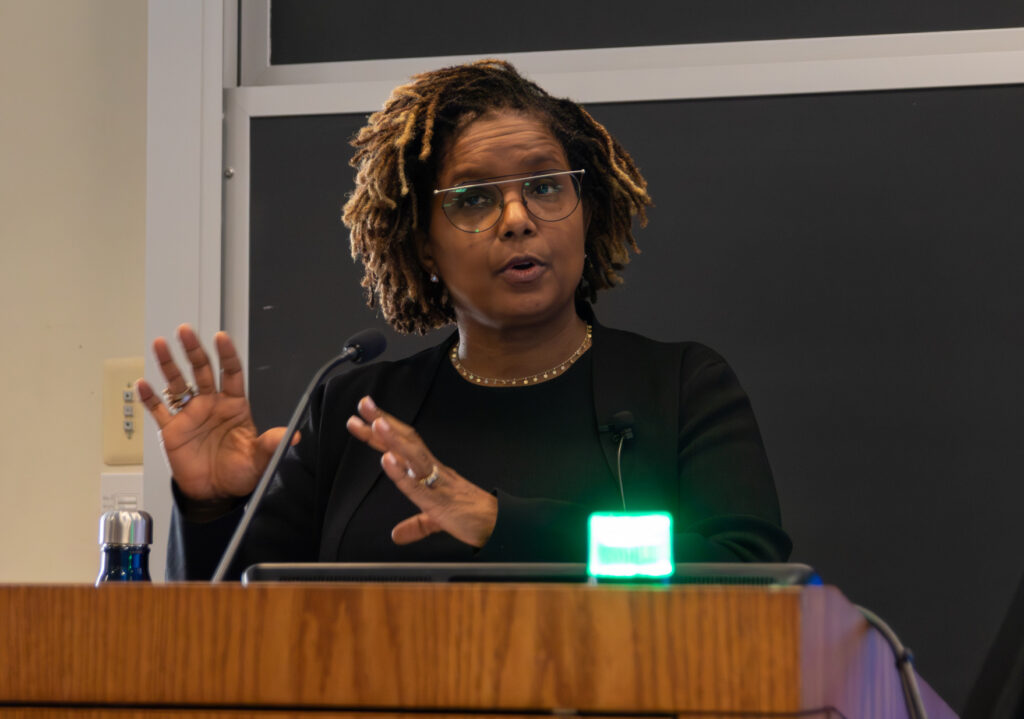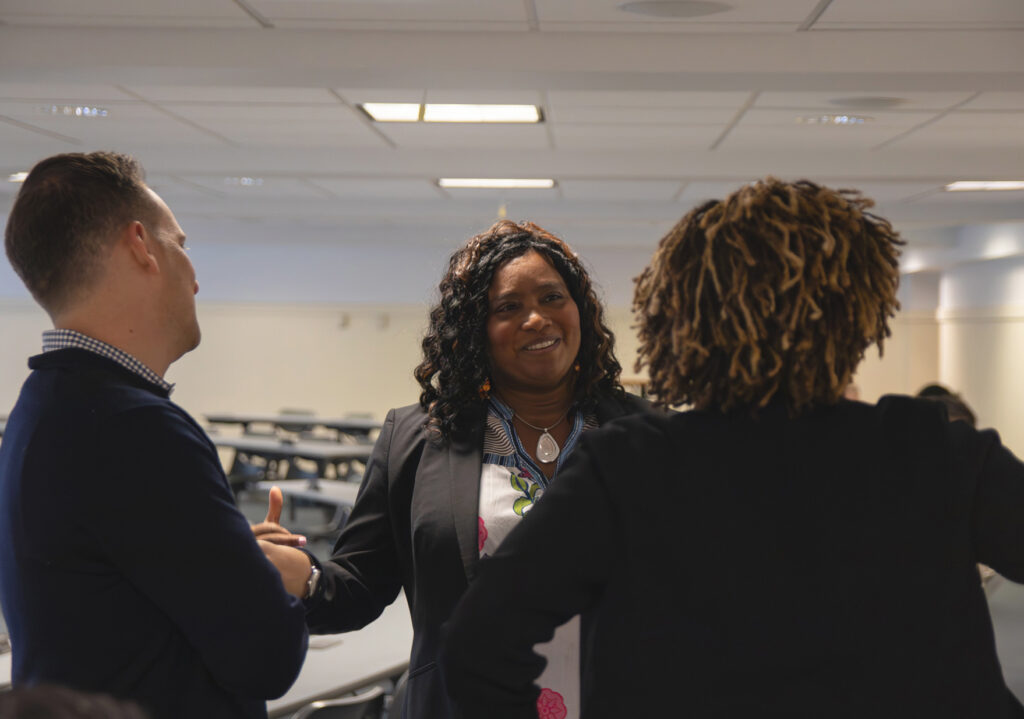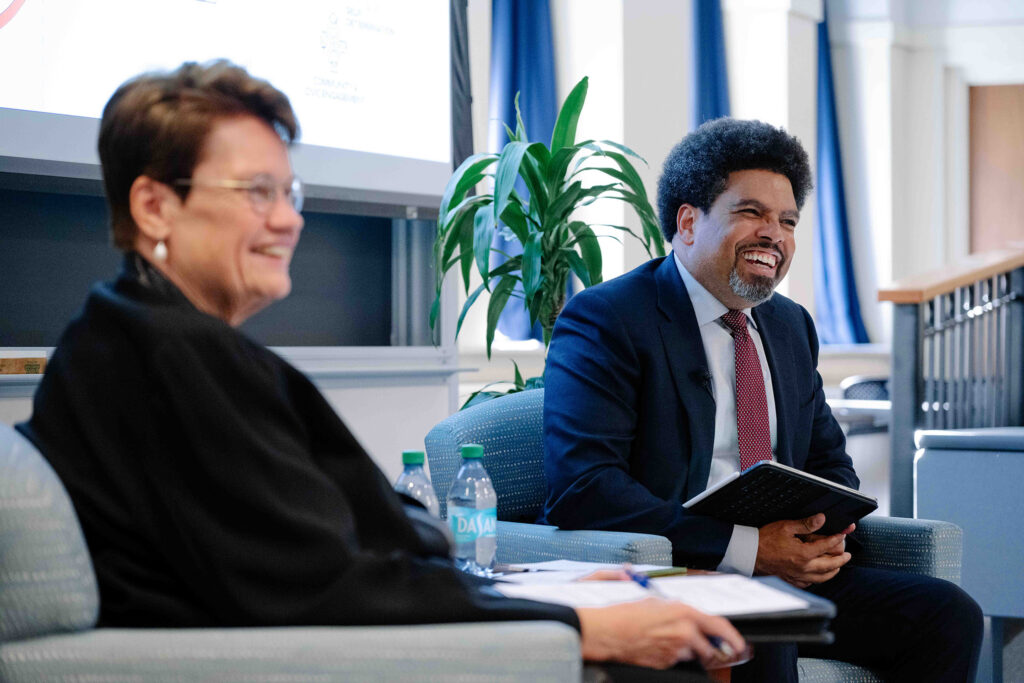The need for innovation in the field of property rights was a central, and sometimes optimistic, theme of a BC Law conference, at which it was noted that institutional failures and systemic breakdowns—such as the devastation after Hurricane Katrina—actually provide opportunities for community change and reform.
Keynote speaker Sheila R. Foster, a professor of climate and law at Columbia University, set the tone of the October event with a lecture titled “Property, People, and the Power to Solve Problems: From Resources to Resilience.” “This question of who gets access to land, water, housing, and energy is up for grabs, and what we see often coming out of these is locally grounded innovations that reimagine property rights and adaptive legal frameworks,” Foster said.
The keynote opened up the Real Property Law Roundtable, affectionately known as the “Real Property Law Schmooze,” for invited legal and non-legal scholars studying real property from across the United States. The research workshop is the Initiative on Land, Housing, & Property Rights’ (ILHPR) newest program offering intended to encourage an interdisciplinary exchange of ideas on issues of real estate, property, housing, or asset-building challenges. ILHPR was founded and is directed by Thomas W. Mitchell, the Robert Drinan S.J. Professor of Law, and the interdisciplinary scholarly-research-convening program was led by the initiative’s Faculty Director of Housing and Property Rights Programs, Lisa Alexander.
In addition to Foster’s keynote address, the gathering included several panels—comprising numerous scholars, experts, and advocates well versed in property and housing issues—and a fireside chat between Darrick Hamilton, professor of economics and urban policy at the New School for Social Research, and BC Law Professor Patricia McCoy.
In her welcome to all of the participants, Dean Odette Lienau explained the importance of ILHPR. “All of you know these issues just as well as anyone else the nation is experiencing—escalating housing prices to rents, fluctuating mortgage rates, rising evictions, the criminalization of homelessness, increasing racial and economic hostility and political division, and also dwindling federal resources to support solutions to all of these areas,” she said. “So, it is so essential for us here at the academy, studying here in the academy, also to remain undeterred and focused on developing thoughtful solutions for the future.”

Foster’s speech focused on how areas of institutional failure and systemic breakdown provide opportunities for community change and innovation. “This question of who gets access to land, water, housing, and energy is up for grabs, and what we see often coming out of these is locally grounded innovations that reimagine property rights and adaptive legal frameworks,” she said.
By way of example, she presented three case studies, starting with 2005’s Hurricane Katrina in Louisiana, and its aftermath. Systemic failure led to the devastation of lower-income communities and created barriers when rebuilding, in part because of lower home values and a lack of financial support due to decades of disinvestment. The result: high levels of displacement and climate gentrification.
In the wake of the destruction, however, two local organizations, the Center for Sustainable Engagement and Development and Sankofa, reaffirmed property rights by protecting infrastructure and creating a Sankofa wetland park with community stewardship, respectively.
“What we learn from this story, and then later on, is the agency of residents in these communities, right?” Foster said. “They show what’s possible when residents have agency; local leaders and even social entrepreneurs can play a vital role in rebuilding. These innovations are real and their models are replicable, but they require something else—they require an enabling environment to scale.”
Innovative examples she cited elsewhere included Buffalo, New York’s land bank named the Green Development Zone in the city’s West Side, and Sunset Park in Brooklyn, New York City’s Green Resilience Industrial District.
Foster cautioned listeners not to romanticize these innovations, as many face pushback, uncertainty, and funding concerns, but she emphasized that these innovations work and can scale. The case studies all benefitted from enabling environments, such as political or legal frameworks, and were interdisciplinary.
“One of the things that makes these organizations so effective is that they’re trusted intermediaries who can translate community priorities into technically viable projects,” Foster said. “They can translate institutional technical requirements back to residents in accessible terms. And they can build trust, often in communities that have lost trust in institutions—from the city to the state to the federal government to the private sector. But here’s the critical interdisciplinary piece: These intermediaries don’t work alone.”

They have weathered different political environments, funding freezes, and areas of uncertainty, Foster said, and she called for action in protecting the enabling financial and political environments that allow community innovation to flourish. Resilience, she noted, does not need to come from the top down.
“They [community organizations] survive, I think, because these are collaborative, adaptive, and deeply rooted in the public community, private civic partnerships,” she explained. “They survive because they built what I think is the scaffold for transformation: the legal, financial governance, and knowledge-enabling environment that allows these to take root and spread.”
Among the other issues examined at the conference was ending the racial wealth gap, which was the subject of the fireside chat between McCoy and Hamilton.
In 2010, Hamilton proposed to end the racial wealth gap with baby bonds, which he called the “birthright to capital,” providing people with economic agency from birth. The accounts would be “seeded” according to wealth, then be transferred from the government to the assignee when the assignee comes of age. He said that would enable them to purchase specific items such as a home or an education free of debt.
After all, Hamilton asked, “What is the purpose of an economy? It should center people and the environments in which we live.” It should promote health, human flourishing, innovation, and community engagement. Baby bonds are just one element of “economic rights,” as Hamilton contended, arguing that governments have the duty to provide citizens with rights and the resources to participate in the economy. The rights, he noted, also need to be inclusive.
The disparities in wealth between white families and Black families are stark, McCoy and Hamilton illustrated, and even as Black families purchase homes, systemic inequalities remain. Hamilton advocated for reparations in addition to baby bonds.
“If we want to do public policy differently [than in] the past to get out of this notion that poverty and inequality is driven by deficit behaviors or attitudes, we need a truth in reconciliation,” Hamilton pointed out. “And if we understand that poverty and inequality is resource deprivation, that that’s what it’s rooted in, then we do public policy differently going forward.” Such action benefits not only Black people but also white people, he argued, “and it’s simply the right thing to do.”


